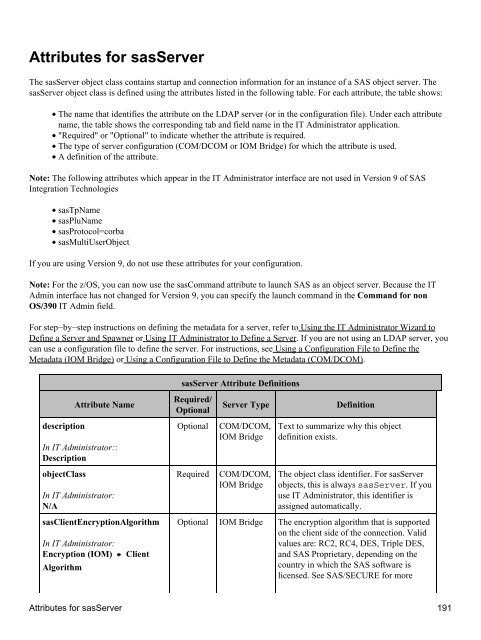SAS® Integration Technologies: Administrator's Guide (LDAP Version)
SAS® Integration Technologies: Administrator's Guide (LDAP Version)
SAS® Integration Technologies: Administrator's Guide (LDAP Version)
Create successful ePaper yourself
Turn your PDF publications into a flip-book with our unique Google optimized e-Paper software.
Attributes for sasServer<br />
The sasServer object class contains startup and connection information for an instance of a SAS object server. The<br />
sasServer object class is defined using the attributes listed in the following table. For each attribute, the table shows:<br />
• The name that identifies the attribute on the <strong>LDAP</strong> server (or in the configuration file). Under each attribute<br />
name, the table shows the corresponding tab and field name in the IT Administrator application.<br />
• "Required" or "Optional" to indicate whether the attribute is required.<br />
• The type of server configuration (COM/DCOM or IOM Bridge) for which the attribute is used.<br />
• A definition of the attribute.<br />
Note: The following attributes which appear in the IT Administrator interface are not used in <strong>Version</strong> 9 of SAS<br />
<strong>Integration</strong> <strong>Technologies</strong><br />
• sasTpName<br />
• sasPluName<br />
• sasProtocol=corba<br />
• sasMultiUserObject<br />
If you are using <strong>Version</strong> 9, do not use these attributes for your configuration.<br />
Note: For the z/OS, you can now use the sasCommand attribute to launch SAS as an object server. Because the IT<br />
Admin interface has not changed for <strong>Version</strong> 9, you can specify the launch command in the Command for non<br />
OS/390 IT Admin field.<br />
For step−by−step instructions on defining the metadata for a server, refer to Using the IT Administrator Wizard to<br />
Define a Server and Spawner or Using IT Administrator to Define a Server. If you are not using an <strong>LDAP</strong> server, you<br />
can use a configuration file to define the server. For instructions, see Using a Configuration File to Define the<br />
Metadata (IOM Bridge) or Using a Configuration File to Define the Metadata (COM/DCOM).<br />
description<br />
Attribute Name<br />
In IT Administrator::<br />
Description<br />
objectClass<br />
In IT Administrator:<br />
N/A<br />
sasClientEncryptionAlgorithm<br />
In IT Administrator:<br />
Encryption (IOM) Client<br />
Algorithm<br />
sasServer Attribute Definitions<br />
Required/<br />
Optional<br />
Optional<br />
Required<br />
Server Type<br />
COM/DCOM,<br />
IOM Bridge<br />
COM/DCOM,<br />
IOM Bridge<br />
Definition<br />
Text to summarize why this object<br />
definition exists.<br />
The object class identifier. For sasServer<br />
objects, this is always sasServer. If you<br />
use IT Administrator, this identifier is<br />
assigned automatically.<br />
Optional IOM Bridge The encryption algorithm that is supported<br />
on the client side of the connection. Valid<br />
values are: RC2, RC4, DES, Triple DES,<br />
and SAS Proprietary, depending on the<br />
country in which the SAS software is<br />
licensed. See SAS/SECURE for more<br />
Attributes for sasServer 191
















